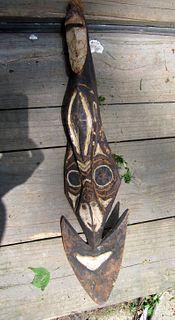Rare Museum Fossil Prehistoric Baby Orthacanthus
Lot 170
About Seller
Artemis Fine Arts
686 S Taylor Ave, Ste 106
Louisville, CO 80027
United States
Selling antiquities, ancient and ethnographic art online since 1993, Artemis Gallery specializes in Classical Antiquities (Egyptian, Greek, Roman, Near Eastern), Asian, Pre-Columbian, African / Tribal / Oceanographic art. Our extensive inventory includes pottery, stone, metal, wood, glass and textil...Read more
Estimate:
$38,000 - $58,000
Absentee vs Live bid
Two ways to bid:
- Leave a max absentee bid and the platform will bid on your behalf up to your maximum bid during the live auction.
- Bid live during the auction and your bids will be submitted real-time to the auctioneer.
Bid Increments
| Price | Bid Increment |
|---|---|
| $0 | $25 |
| $300 | $50 |
| $1,000 | $100 |
| $2,000 | $250 |
| $5,000 | $500 |
| $10,000 | $1,000 |
| $20,000 | $2,500 |
| $50,000 | $5,000 |
| $100,000 | $10,000 |
| $200,000 | $20,000 |
About Auction
By Artemis Fine Arts
Oct 11, 2018
Set Reminder
2018-10-11 10:00:00
2018-10-11 10:00:00
America/New_York
Bidsquare
Bidsquare : Exceptional Antiquities | Ethnographic Art
https://www.bidsquare.com/auctions/artemis-gallery/exceptional-antiquities-ethnographic-art-3500
An important one-day auction featuring museum-worthy examples of classical antiquities, ancient and ethnographic art from cultures encompassing the globe. Artemis Fine Arts info@artemisfinearts.com
An important one-day auction featuring museum-worthy examples of classical antiquities, ancient and ethnographic art from cultures encompassing the globe. Artemis Fine Arts info@artemisfinearts.com
- Lot Description
Orthacanthus (Lebachacanthus). Found in Rheinland Pfalz, Germany. Permian, 260 million years ago. Not to be confused with the much smaller Permian Xenacanthus sp. shark that looks similar, the Orthacanthus shark was substantially larger than Xenacanthus. Small complete Orthacanthus shark fossils are extremely rare. This shark was an apex predator with no equal, from a time before the dinosaurs. Baby Orthacanthus fossils are rare, because it is believed they were cannibalized by adult sharks when they died early in life and therefore, the small juveniles were not as prevalent to fossilize as the adults. Another reason they are rare in the fossil record is that their skeletons are so fragile and delicate that surviving the fossil record would have been very limited and only under idea conditions. Size: 20" L x 15.5" H (50.8 cm x 39.4 cm); shark is 22" L (55.9 cm)
This is one of the smallest complete Orthacanthus senckenbergianus fossil baby sharks known. It is complete with full skeletal structure articulated in its original natural white state. This shark dates back to the Permian Period, 260 million years ago before the first dinosaur walked our planet. All the anatomy of the shark is present which is EXTREMELY RARE in such a small, juvenile specimen due to the very delicate structure of the skeleton. The entire skeleton and all fin rays are articulated and whole. The method of preparation used retained and exposed all of the anatomical detail in its original multi-dimensional nature. The white color of the skeleton is natural and a result of volcanic burial unique to this geological formation where the heat of the ash turned the skeleton white. The entire slab is reinforced with epoxy and is an even .75" in overall thickness. The slab is secure and safe for a custom wall mount application.
From a period in time before the dinosaurs even walked the earth, the bizarre Orthacanthus thrived in prehistoric swamps and bayous in Europe and North America. The Orthacanthus was an ancient freshwater shark that is no longer in existence. It had a very long spine protruding from the back of the head followed by a long ribbon-like dorsal fin that gave it the appearance of an eel. The double forked teeth were another unique characteristic. A full grown Orthacanthus is believed to have grown to 10 feet in length and was THE most dangerous apex predator that terrorized all creatures that lived in its environment.
NOTE: This is an extremely rare baby orthacanthus. One of the smallest baby orthacanthus shark specimens known of the few rare examples encountered. Few baby fossils of this shark have ever survived the fossilization process due to the fragile nature of their skeleton.
SPECIAL NOTE: The current laws in this state of Germany have forbid the collection of these remarkable fossils since 1986. This legislation has permanently ended the supply of such magnificent specimens such as this one being offered here. This rare example was originally collected years prior to the ban.
Provenance: private Florida, USA collection, acquired in 2006 from a private German collection
All items legal to buy/sell under U.S. Statute covering cultural patrimony Code 2600, CHAPTER 14, and are guaranteed to be as described or your money back.
A Certificate of Authenticity will accompany all winning bids.
We ship worldwide and handle all shipping in-house for your convenience.
#139682Typical repair with filled cracks. White color to shark is natural. Shark complete with no compositing of other shark parts. Rock plate sealed and reinforced on back with epoxy and hanger.Condition
- Shipping Info
-
All shipping is handled in-house for your convenience. Your invoice from Artemis Gallery will include shipping calculation instructions. If in doubt, please inquire BEFORE bidding for estimated shipping costs for individual items.
-
- Buyer's Premium



 EUR
EUR CAD
CAD AUD
AUD GBP
GBP MXN
MXN HKD
HKD CNY
CNY MYR
MYR SEK
SEK SGD
SGD CHF
CHF THB
THB















